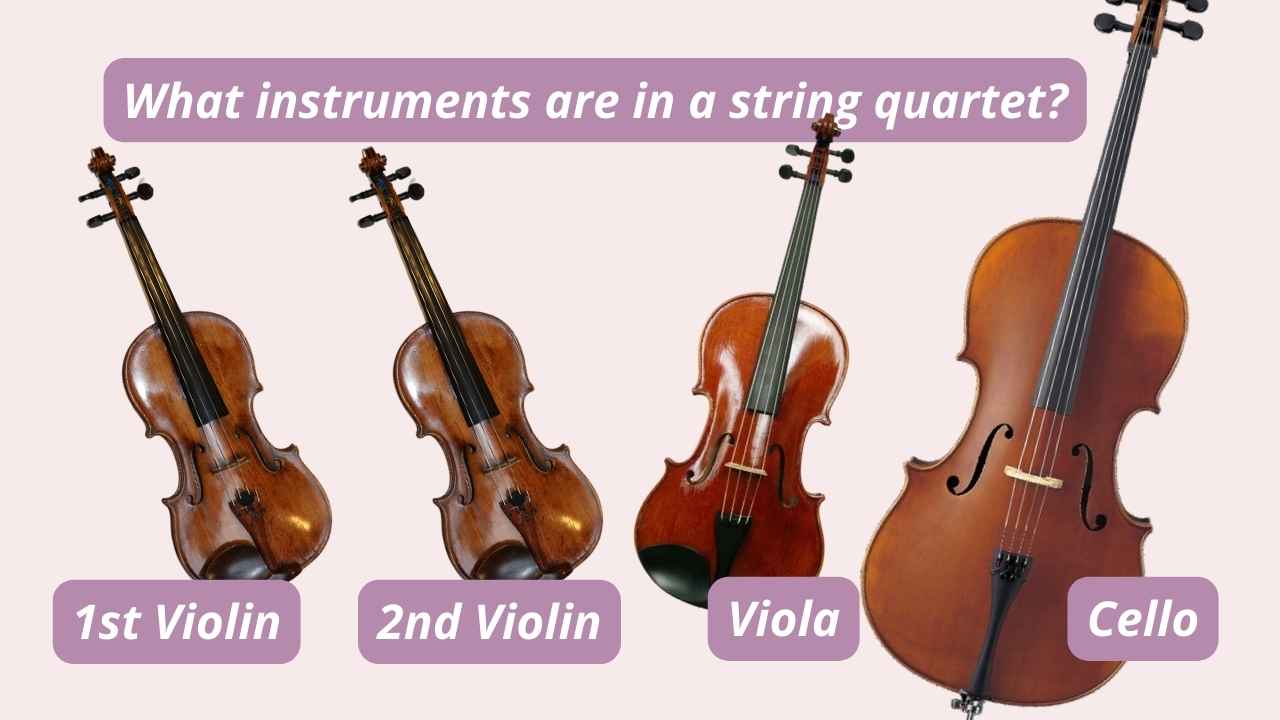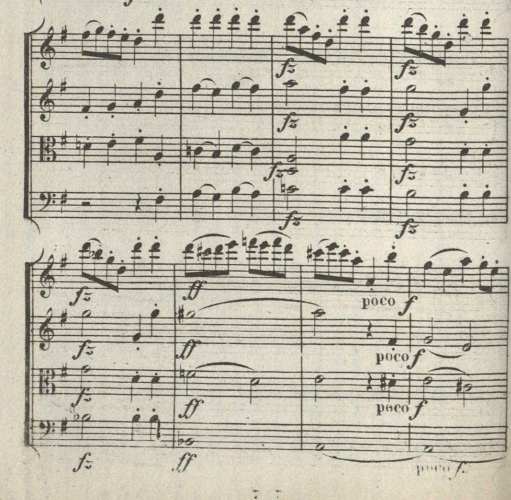A Beginner’s Guide to String Quartets
The instruments, history and iconic works explained to classical music newbies
“The string quartet is the essence of music, with its perfect balance and intimate conversation among the instruments.” – Wolfgang Amadeus Mozart
If you’re relatively new to classical music, you’ll quickly encounter the string quartet. Maybe your interest is spiked by the beautiful string quartet music in the Bridgerton series. In this blog post I’m going to tell you all about the instruments in a string quartet and the beautiful music written for this ensemble throughout the centuries.
What instruments are in a string quartet?
A string quartet is one of the most popular and enduring ensembles in classical music. It comprises four instruments: two violins, a viola, and a cello. Each instrument contributes a unique voice and character to the ensemble, creating a rich tapestry of sound.

Violins
The first and second violins are the same instruments, but they play a different part and have a different role in the string quartet.
- First Violin: Often plays the melody or the highest part. The first violin typically leads the group and may play more virtuosic passages.
- Second Violin: Plays harmony and counter-melodies, providing support to the first violin. The second violin’s role is crucial in creating the quartet’s overall balance.
Viola
The viola looks a lot like a violin and is held in the same way, but it’s a bit bigger.
- Tuning: Tuned a fifth below the violin (C-G-D-A).
- Characteristics: The viola has a deeper, richer sound than the violin, often described as warm and mellow. It plays both melody and harmony, filling the middle range of the quartet’s sound.
Cello
The cello rests on the floor on it’s endpin and is held between the knees of the player. This is the biggest instrument in a string quartet with the lowest sound.
- Tuning: Tuned an octave below the viola (C-G-D-A).
- Characteristics: The cello provides the bass foundation for the quartet, offering a deep, resonant tone. It often plays the bass line but can also carry the melody.
Tuning and Characteristics
All string instruments in a quartet are tuned in perfect fifths, except the cello, which is tuned in a perfect octave compared to the viola. This tuning allows for a wide range of notes and rich harmonies. The instruments’ timbres combine to create a full, balanced sound:
- Violins: Bright and piercing tones.
- Viola: Warm and rich tones.
- Cello: Deep and resonant tones.
For more information on the differences between the violin, viola and cello, their open string tuning and their playing ranges, watch this video.
Characteristics of String Quartet Music
A string quartet typically follows a four-movement structure, a format that became standard during the Classical period. Each movement has distinct characteristics, contributing to the overall narrative and emotional arc of the piece.
- First Movement: Usually in sonata form and set at a fast tempo (Allegro). This movement often establishes the main themes and sets the tone for the entire quartet.
- Second Movement: Slower and more lyrical (Adagio or Andante). It provides a contrast to the energetic first movement, often showcasing the quartet’s expressive capabilities.
- Third Movement: A dance-like movement, either a Minuet and Trio or a Scherzo. The Minuet is more stately, while the Scherzo is quicker and more playful.
- Fourth Movement: The finale, usually fast and lively (Allegro or Presto). It brings the quartet to an exciting and often climactic conclusion.
This structure allows composers to explore a wide range of emotions and musical ideas within a single work, making the string quartet a versatile and expressive ensemble.
String Quartet Sheet Music
In this image you see the score for the Haydn string quartet op 76 no 1. A score means that you see all four parts. On top you see the first violin in the treble clef. You can see this is the highest voice with most melodic lines. The second line is for the second violin. Although the instrument is the same, you’ll notice the lower pitch and less melody. The third line is in the alto cleff and is for the viola. The fourth line is in the bass cleff and is for the cello.
When playing a string quartet the musicians don’t have this complete score on their music stand. They do use it to study at home and prepare for the rehearsal, so they are aware of the complete piece of music and not just their own part. When playing together, each musician has their own part. The first violinist only sees the first violin part. Playing a bowed instrument requires two hands and playing straight from the score would mean lots of page turning.

Development of the String Quartet
Classical Period
The string quartet emerged in the mid-18th century, with Joseph Haydn playing a pivotal role in its development. Often referred to as the “father of the string quartet,” Haydn’s contributions were crucial in establishing the quartet’s form and style. His early quartets were lighter, resembling divertimentos, but over time, he developed a more sophisticated approach, integrating complex thematic development and intricate counterpoint.
Other key composers from the Classical period include:
- Wolfgang Amadeus Mozart: Expanded the expressive range of the quartet, incorporating operatic and symphonic elements.
- Ludwig van Beethoven: Revolutionized the string quartet, pushing its technical and emotional boundaries. His late quartets, in particular, are celebrated for their profound depth and innovation. Some argue that Beethoven is the first romantic composer.
Listen to some string quartets from the classical period:
Romantic Period
During the Romantic period, the string quartet continued to evolve, with composers exploring new emotional and harmonic landscapes.
- Franz Schubert: His quartets are known for their lyrical beauty and emotional intensity, particularly the famous “Death and the Maiden” quartet.
- Felix Mendelssohn: Combined classical forms with Romantic expressiveness, creating quartets that are both elegant and deeply felt.
- Johannes Brahms: His quartets are marked by their structural complexity and rich harmonic language, reflecting his meticulous craftsmanship.
Listen to some string quartets from the romantic period:
Modern Era
In the 20th century, the string quartet saw further innovation as composers experimented with new techniques and styles.
- Béla Bartók: Integrated folk music elements and modernist techniques, creating quartets that are rhythmically and harmonically adventurous.
- Dmitri Shostakovich: Used the quartet to express personal and political themes, with works that are both deeply personal and universally resonant.
- Arnold Schoenberg: Introduced atonality and twelve-tone techniques, challenging traditional harmonic conventions and expanding the quartet’s expressive potential.
Listen to some string quartets from the modern era:
Get to know more string quartets in this video about the evolution of string quartets featuring 33 famous string quartet pieces.
Top 5 String Quartets Ever Written
Here are some famous string quartets that you really must listen.
Early to Modern String Quartet Masterpieces
Ludwig van Beethoven – String Quartet No. 14 in C-sharp minor, Op. 131
A profound and innovative work, known for its continuous seven-movement structure.
Franz Schubert – String Quartet No. 14 in D minor, “Death and the Maiden”
A dramatic and emotional piece, exploring themes of life and death.
Joseph Haydn – String Quartet in C Major, Op. 76, No. 3 “Emperor”
Famous for its second movement, which became the German national anthem.
Dmitri Shostakovich – String Quartet No. 8 in C minor, Op. 110
A haunting and powerful work, reflecting the composer’s personal and political struggles.
Béla Bartók – String Quartet No. 4
An innovative piece, blending folk music influences with modernist techniques.
8 Best String Quartet Groups Today
Here are some of the best string quartet groups performing today, known for their exceptional musicianship, diverse repertoire, and critical acclaim:
Kronos Quartet
Renowned for their innovative approach, the Kronos Quartet has been at the forefront of contemporary and world music for over four decades. They are known for their collaborations with a wide range of composers and artists, bringing new and eclectic music to the string quartet repertoire.
Emerson String Quartet
One of the most celebrated string quartets in the world, the Emerson String Quartet is acclaimed for their technical precision and expressive interpretations. They have an extensive discography and have won numerous awards, including multiple Grammy Awards.
Takács Quartet
The Takács Quartet is known for their deep understanding and interpretation of classical and romantic string quartet repertoire. They have received international acclaim for their performances and recordings, particularly of Beethoven and Bartók quartets.
Danish String Quartet
This group is celebrated for their dynamic and adventurous performances. They seamlessly blend classical works with contemporary and folk music, showcasing their versatility and innovative spirit.
Belcea Quartet
The Belcea Quartet is praised for their powerful and emotive performances. They have a broad repertoire that spans from classical to modern works, and they are known for their insightful interpretations and cohesive ensemble playing.
Jerusalem Quartet
The Jerusalem Quartet is recognized for their polished and refined performances. They have a rich discography and are especially known for their interpretations of works by Haydn, Beethoven, and Shostakovich.
Quatuor Ébène
This French quartet is known for their versatility, performing both classical and jazz music. They are admired for their technical brilliance and unique, expressive interpretations.
Borodin Quartet
The Borodin Quartet has a long and distinguished history, particularly noted for their performances of Russian repertoire, including the works of Shostakovich and Tchaikovsky.
These quartets are among the most respected and influential groups performing today, each bringing their unique style and expertise to the world of string quartet music.
String Quartets in popular and crossover music
String quartets have increasingly ventured into crossover and popular music, bridging the gap between classical traditions and contemporary genres. This fusion allows quartets to reach broader audiences and explore new musical landscapes. For example, Bond is a British-Australian electric string quartet known for blending classical music with pop, dance, and electronic elements. Vitamin String Quartet has gained fame for their classical renditions of popular songs from various genres, including rock and pop, often featured in TV shows like “Bridgerton.” Apocalyptica, originally a classical string quartet from Finland, is famous for their heavy metal renditions, particularly of Metallica songs. 2Cellos, while not a traditional string quartet, has made a significant impact with their rock and pop covers, showcasing the cello’s versatility. Lastly, the Turtle Island Quartet has seamlessly integrated jazz, classical, and popular music, creating innovative arrangements that transcend genre boundaries. These ensembles demonstrate the versatility of string quartets and their ability to adapt to and influence modern music.

Hi! I'm Zlata
Classical violinist helping you overcome technical struggles and play with feeling by improving your bow technique.
More chamber music ensembles to explore
If you love string quartet music, you’ll also love these other chamber music groups that can be seen as modifications of the string quartet:
String Quintet – Adds a 5th string instrument using 2 Violas – 2 Cellos or a Double Bass
String Trio: 1 Violin, 1 Viola and 1 Cello
Piano Quartet: a String Quartet with 1 Violin replaced by a Piano
Piano Quintet: a String Quartet with a Piano
String Sextet: has 2 Violins, 2 Violas and 2 Cellos
Closing notes 🎵
From the pioneering works of Haydn and Beethoven to the innovative compositions of Bartók and Shostakovich and the pop hits in Bridgerton, the string quartet repertoire is vast and very rewarding to listen to. I hope this blog post has helped you to understand more about the instruments in a string quartet and explore some of the most beautiful music of the past and present.
What’s your favourite string quartet music? Leave a comment!

0 Comments